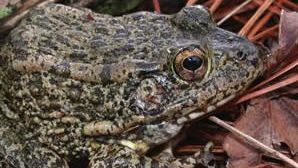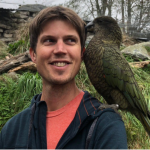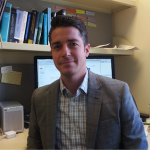SE CASC Spring 2021 Science Seminars
Join us this spring for a virtual science seminar series highlighting SE CASC funded projects
supporting resource management actions across the Southeast.
Past presentations in this series:
Structured Decision Making: A Strategy for Collaboration and Conservation of Imperiled Herpetofauna
Dr. Brian Crawford, Georgia Cooperative Fish & Wildlife Research Unit
February 16 | 11AM ET
View a recording of this presentation.
Webinar Overview:

Structured decision making (SDM) is a process that helps decision makers and stakeholders solve complex conservation problems by breaking them into a sequence of more tractable components based in values and science. We highlight the benefits of SDM using a case study on range-wide strategic conservation planning for the gopher frog. We used SDM with State, federal, and other partners to identify optimal management strategies for the gopher frog across 183 sites that maximize the number and distribution of breeding populations in 2050 while minimizing cost. We combined species data and expert judgment to model population persistence under three scenarios: 1) “status quo” management (least costly actions), 2) “do-all-we-can” management (most costly), and 3) “cost-effective” management where we identified optimal strategies that balance population outcomes and cost. Models predicted a reduction in persisting populations, relative to current conditions, across all three scenarios. Cost-effective strategies slowed population declines expected under status quo options and included a combination of managing uplands and wetlands at currently occupied sites as well as establishing new populations via head-starting and translocations. Our results can aid partners in implementing optimal conservation strategies at site-, state-, and range-wide scales when resources are limited and inform forthcoming listing decisions of the U.S. Fish & Wildlife Service. Learn more about the SE CASC project associated with this work.
Learn more about the Speaker:

Brian A. Crawford, Ph.D. is a postdoctoral conservation ecologist working in the Georgia Cooperative Fish & Wildlife Research Unit at the University of Georgia. His research integrates natural and social sciences to better understand and resolve human-caused impacts on wildlife. Much of his work focuses on developing decision support tools with partners (biologists, managers, decision-makers) for identifying optimal management strategies for recovering at-risk species of herpetofauna. More information on Brian is available here.
Using Information From Global Climate Models to Inform Policymaking and Natural Resource Decision Making
Dr. Adam Terando, Southeast Climate Adaptation Science Center
March 16 | 11AM ET View a recording of this presentation.
Webinar Overview:
Climate change is a risk management challenge for society and natural resource managers because of the uncertain consequences for natural and human systems across decades to centuries. Climate-related science activities within the USGS emphasize research on adaptation to climate change. This research helps inform adaptive management processes and planning activities within other DOI bureaus and by DOI stakeholders. Global climate models are sophisticated numerical representations of the Earth’s climate system. Research groups from around the world regularly participate in a coordinated effort to produce a suite of climate models. This global effort provides a test bed to assess model performance and analyze projections of future change under various prescribed climate scenarios. These climate scenarios describe a plausible future outcome associated with a specific set of societal actions. Examining a range of projected climate outcomes based on multiple scenarios is a recommended best practice because it allows decision makers to better consider both short- and long-term risks and opportunities. In this talk, Dr. Terando will discuss these topics and how information from climate scenarios and global climate models can best be used to help inform natural resource management decisions in a warming planet.
Learn more about the speaker:

Dr. Adam Terando is a Research Ecologist with the US Geological Survey at the Southeast Climate Adaptation Science Center located at North Carolina State University. A climate scientist by training, his research focuses on the risks posed by climate and land use change to ecosystems, and the complex human-environment relationships that drive these processes. This includes understanding climatically-induced changes to fire in the Southeast US, simulating suburban growth patterns, and developing ultra high-resolution climate projections for the U.S. Caribbean. He has served as the federal coordinating lead author for the Southeast Chapter of the recently issued Fourth National Climate Assessment and as a co-author on the North Carolina Climate Science Report.
Strategic Habitat Conservation for the Brown Pelican: Estimating Habitat Objectives and Management Scenario Efficiencies
Dr. James Cronin, USGS Wetland and Aquatic Research Center
April 20 | 11AM ET
View a recording of this presentation.
Webinar Overview:
Gulf restoration programs increasingly fund coastal habitat managers to implement a variety of restoration actions to meet species’ needs and recover from injuries. There is uncertainty about the ability of these management actions to achieve population objectives because species are often stressed by factors that interact and differentially influence their abundances and distributions across large scales. This makes it difficult for managers to establish habitat objectives and translate them into the actions necessary to meet population objectives. To address this problem, we developed fifteen USFWS Biological Planning Units (BPU) for the Northern Gulf of Mexico. Ten of these BPUs have established population objectives (breeding pairs) for Brown Pelican (Pelecanus occidentalis), which form breeding colonies on coastal and barrier islands. We developed a Bayesian network model and a geospatial habitat characteristic dataset to predict the number of Brown Pelican nests on each of 31,577 islands within target BPUs. We used the model’s results and population objectives to estimate nest demand per target BPU. Finally, we estimated how much habitat is needed in each BPU to achieve its population objective (i.e., habitat objective) and the amount of effort needed to achieve the habitat objective (i.e., management efficiency). We will discuss how managers can use these products as decision-aiding tools for identifying which islands could be targeted and what actions could be taken to achieve Brown Pelican population objectives. Learn more about Biological Objectives for the Gulf Coast project.
Learn more about the Speaker:

James Patrick Cronin is a Research Ecologist at the USGS Wetland and Aquatic Research Center in Lafayette, Louisiana. His projects generally focus on developing causal models that can inform ecological theory and aid natural resource managers and planners. Specific areas of research include trophic interactions, infectious diseases, functional traits, and coastal landscape conservation and restoration, with a focus on threatened, endangered, and at risk species. For links to his research, see his Google scholar profile or research gate profile.
